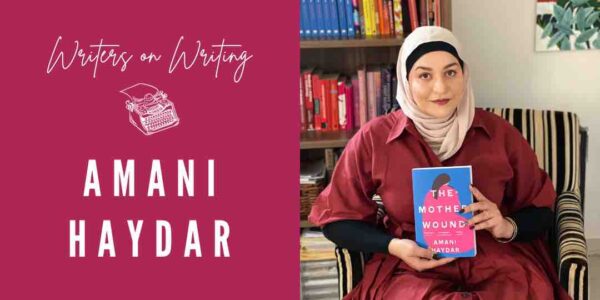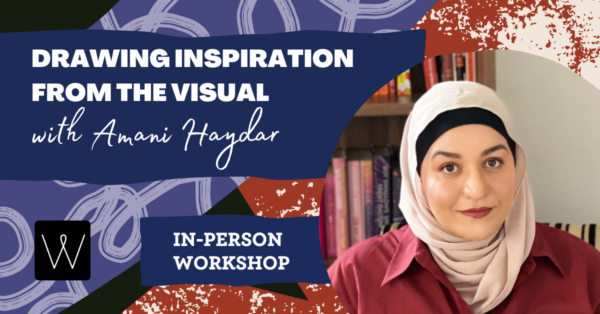
Writers on Writing is our regular conversation with a writer or industry professional about the writing craft, industry insights, and their own practice. This week, we spoke to award-winning writer and visual artist Amani Haydar about the intersections of visual art and writing, ahead of her workshop Drawing Inspiration from the Visual on 4 November at Writing NSW.
Does a writer need to have a technical understanding of art in order to best use it as inspiration?
Visual art generally aims to transcend language, so an artwork can inspire a writer whether they have a technical understanding or not. Effective artworks don’t need to be explained in words to be understood, but visual literacy is a skill that can be developed and refined. A technical understanding may help a writer ‘read’ an artwork on a deeper level. Understanding the elements of an artwork like colour, line and direction provides us with information on what to look for to better grasp the artist’s intent.
That said, there is no objective or ‘correct’ response to any given piece of visual art. People often find the art world elitist and exclusionary, especially when the focus is on defining ‘good art’ as opposed to validating the diverse subjective responses of audiences.
Do you find painting and writing equal parts challenging and soothing, or does one art form challenge you more than another?
Both are challenging and soothing. Something about painting and drawing comes a little more naturally to me. Perhaps that’s because it’s more of an embodied experience. Often when I’m writing I get caught up in the intellectual side of it and that can make it feel harder; judgment and perfectionism can get in the way of my flow. My goal is to trust and enjoy the writing process as much as I trust and enjoy the painting process. It takes practice, but I’m getting there gradually.
You were a finalist in the Archibald Prize a few years ago with a self portrait, and you’ve also written about deeply personal topics in your book The Mother Wound. How do you find the courage to share this kind of self reflection with the world?
I often think of that self-portrait as my book emerging from me before I had all the words for it. So, the act of creating that gives me the courage to do more creating. Writing about abuse, violence, and grief can involve a lot of shame and self-doubt but I think you get better and better at silencing those doubts each time you tell a story. It helps to know that I’m not just delving into trauma for the sake of it, but because there are important social and political issues surrounding it that must be articulated and interrogated. I felt a real sense of urgency and purpose while writing The Mother Wound and the fact that readers have found it resonant or empowering is incredibly validating to me.
Do you find that writing inspires your painting practice, just as much as artworks inspire your writing practice?
Absolutely. I love the way these processes can feed into each other providing me with unlimited ideas. I never feel like I need to think of something to write or make; if I make time for my creative practice, it comes naturally. That’s why I feel so strongly about building habits that encourage a state of flow. Plus, some things are best said in a painting for example while others need to be laid out in words. Why should we limit ourselves to one job, description or discipline when a multidisciplinary practice might help us say what we want to say more effectively?
There are so many wonderful books about art and artists that weave descriptions of art through the narrative. Could you tell us about a few of your favourites?
My favourite example of this as a young adult was Jane Eyre. I remember being struck by the mysticism of Jane’s drawings and the way they give the reader an insight into her subconscious fears and desires. The images and symbols she draws stand in stark contrast to the rigid Christian society she is a part of. I love that they form a story within the story, one that is private and intimate.
My favourite example of a multidisciplinary practice is the illustrated manuscript for Kahlil Gibran’s The Prophet. I saw the original drawings in a museum once and couldn’t believe that they weren’t published alongside his words in any of the editions I’d come across before. They are dream-like, whimsical, and just as mysterious as his writing.
Amani Haydar is an award-winning writer and visual artist. Her debut memoir The Mother Wound received the 2022 Victorian Premier’s Literary Award for Non-fiction, the ABIA Matt Richell Award for New Writer of the Year, and the Michael Crouch Award for Debut Work at the National Biography Awards. Amani is a former Archibald Prize finalist and has recently illustrated The Very Best Doughnut and Safar: Muslim Women’s Stories of Travel and Transformation.
Join Drawing Inspiration from the Visual, Saturday 4 November 2023, 10am-4pm.
If you want to be the first to read great advice, prompts and inspiration from our incredible tutors, subscribe to our weekly e-newsletter Newsbite.
More from Writing NSW
Check out our full range of writing courses in Sydney, our online writing courses and our feedback programs to see how we can help you on your creative writing journey. Find out about our prizes & opportunities, as well as writing groups across NSW, and sign up to our weekly newsletter for writing events, opportunities and giveaways.

